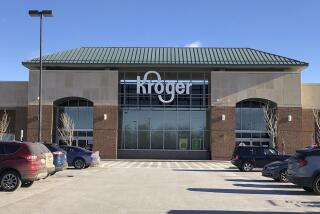Variety Chains Hang On By Diversifying, Renovating
- Share via
While independent variety stores appear headed for extinction, some chains are thriving by updating their stores and holding on tight to their rung near the bottom of the retail price ladder.
“It’s changed quite a bit since the old days,” said Frank Chapman, executive vice president of merchandising for the U.S. Woolworth division.
Woolworth’s variety store sales have improved significantly in recent years since the company launched an extensive remodeling program, he said. In some remodeled stores, sales have jumped 15% to 20% a year.
In 1987, Woolworth’s domestic general merchandising operation, which includes its Woolco discount department stores in addition to variety stores, produced sales of $2.03 billion, up from $1.95 billion the previous year. Operating profit was virtually unchanged at $95 million. Sales per square foot rose to $122 million in 1987 from $112 million the year before.
Woolworth has not stopped at renovating stores; it has virtually repackaged the corporation during the past several years.
The company has diversified heavily into specialty retailing and now owns such chains as Kinney shoe stores, Foot Locker, Little Folk Shop and the Susie’s women’s clothing chain.
Woolworth’s U.S. specialty operations now produce slightly higher sales than the domestic general merchandise business that started it all. But domestic specialty retailing is much more profitable, earning $222 million in 1987.
Thomas R. Hale, president and chief executive of the 99 Only Stores, a fast-growing Los Angeles-based chain, first got a glimpse of the potential of variety store retailing during the 1984 summer Olympics in Los Angeles.
The company, which had only two stores then, began selling Olympic mugs and other items during the games for 99 cents, the chain’s top price level.
“We had to hire security guards to hold customers back,” Hale said. “That really opened our eyes to the possibilities.” The chain now has 23 stores.
Still Has a Market
At Portland, Ore.-based Sprouse-Reitz Stores, a regional chain with 313 stores in 11 Western states, “it is a challenge,” said President Robert A. Sprouse II, grandson of company co-founder Robert Allen Sprouse. (Other founders in 1909 of the then-wholesale business were Robert A. Sprouse’s father, John, and Fred L. Reitz.)
“What we’ve had to do is reposition our merchandise mix and work a little harder on our presentation,” Sprouse said. Sprouse-Reitz (pronounced rites ) has also been aggressively remodeling, something Sprouse blames for the company’s falling profits at a time of rising sales.
In fiscal 1987, Sprouse-Reitz recorded sales of $218.6 million, up 6.3% from the year before. But net earnings fell 45.6% to $1.3 million. An erosion in gross margins, partly because of record markdowns, also contributed to the decline.
In a letter to shareholders, Sprouse said he expects the company to realize “a payback from our investment” and achieve a turnaround in profit this year.
Rising sales indicate that the variety store still has a market to serve, Sprouse said.
“We don’t carry everything from soup to nuts as a large discount department store would do,” he said. “We emphasize convenience. There are some areas where we’re capturing a growing share of a declining market, and the home sewing market is one.”
“In the broader range of general merchandising, the competition is so intense and the margins are so slim,” Sprouse said. “It’s truly survival of the fittest, and the ones that are still around are better competitors because of it.”
Variety stores still attract shoppers “because people just can’t afford the high prices” at mall stores, said one longtime variety store manager. “But we don’t have people breaking the doors down like we did years ago when we had a sale.”
More to Read
Inside the business of entertainment
The Wide Shot brings you news, analysis and insights on everything from streaming wars to production — and what it all means for the future.
You may occasionally receive promotional content from the Los Angeles Times.










